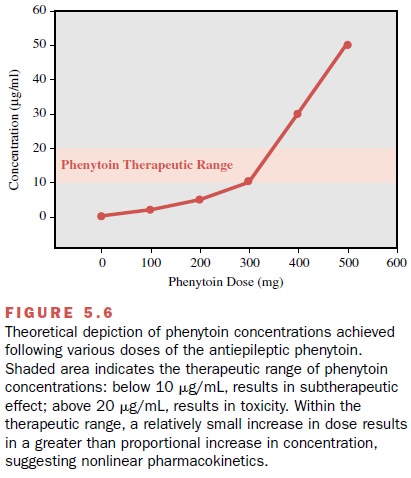Chapter: Modern Pharmacology with Clinical Applications: Pharmacokinetics
Nonlinear Pharmacokinetics
NONLINEAR
PHARMACOKINETICS
The underlying assumption in the discussion of these concepts is that the drug of interest follows linear phar-macokinetic principles; that is, the concentrations achieved are proportional to the dose given. For exam-ple, a doubling of the dose will produce a doubling of the blood concentration. For some drugs, however, this is not the case: an increase in dose may produce a con-centration much greater than expected.

For example, in-creases in dosage of the antiepileptic agent phenytoin above approximately 300 mg daily usually produce a greater than expected
increase in blood concentrations. This is illustrated in the graph of Figure
5.6, which shows that for a hypothetical patient, phenytoin blood
concentrations are plotted against dose of phenytoin. The graph demonstrates
that as one approaches doses that result in therapeutic concentrations of
phenytoin, the rise in concentrations becomes nonlinear such that an increase
in dose from 300 to 400 mg (33% increase) produces a 300% increase in phenytoin
concentration. Thus, it is easy to see how toxicity may arise quickly
fol-lowing what was seemingly a small increase in dose; un-der linear
circumstances such a small increase in dose would have resulted in
concentrations still within the therapeutic range. This nonlinearity often
occurs be-cause the drug-metabolizing enzymes for the drug be-come saturated at
typical blood concentrations, such that despite increases in dose, drug is
still metabolized at the same rate and blood concentrations go up
unex-pectedly. In this case, following Michaelis-Menten en-zyme kinetics, the
maximum velocity (Vmax) has been reached and the rate of drug
metabolism remains con-stant.
Related Topics